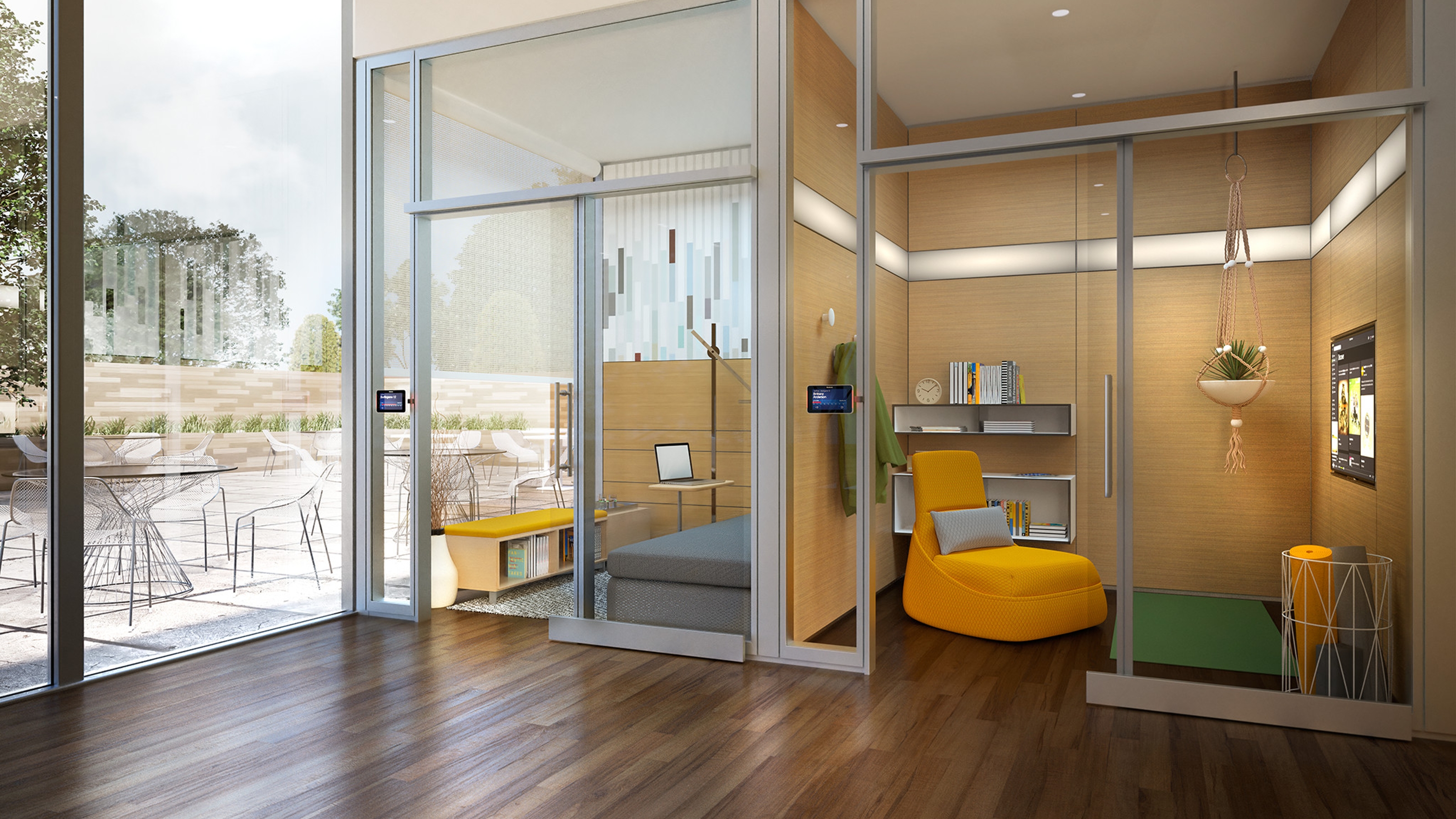A bustling, lively office space has its perks.
It can look great to visitors, for one, because it gives the impression that employees are productive and even having fun.
As we mentioned in our post on open office layouts, open plans where everyone works together in a central area maximize space and natural light. These types of workspaces can also emphasize an egalitarian culture, because everyone works together side by side. Plus, a moderate level of noise and activity can actually be preferable to a silent office when it comes to getting work done.
However, unless there are quiet spaces available to complement the noisier areas of the office, morale and productivity will suffer.
Everyone needs at least a little bit of distraction-free time in their workday. Here’s what you need to know about making sure your employees have quiet space to work.
Everyone Needs Quiet Sometimes
HR experts have long used personality classification systems such as the Myers-Briggs Type Indicator to help employees work more efficiently.
A major component of the Myers-Briggs and other personality theories is a measurement of how individuals tolerate interactions with others. You’ve probably heard the terms “introvert” and “extrovert” by now, for example.
The exact definitions of these terms can vary. But even without a deep dive into psychological theory, we all know some of us need more quiet time than others to thrive. Quiet spaces may be especially important for workers who classify themselves as introverts, but quiet spaces tend to benefit everyone else, too.
As this Deskmag article explains, even coworkers who identify as extroverts choose to work alone for much of their workday. And the reverse is also true: introverts often also enjoy socializing in small groups. Although they need solitary work time, they don’t want to be alone all day long.

It’s also worth noting that most people don’t identify strongly as introverts or extroverts, and they, too, benefit from a healthy mix of solitary and group work.
It’s natural for people to work alone to in pairs to generate ideas or process information, then come together in groups to build on ideas, get feedback, or find consensus. They then work alone to process the new information, and the cycle continues.
If workers don’t have an easy way to get that distraction-free time to process their thoughts, productivity and morale will suffer.
Understand Activity-Based Design
To meet these varied workday needs, savvy employers and coworking spaces are adopting a new type of office design.
In activity-based offices, workers can select their workspace based on the type of work they need to do at any given time. There are quiet spaces for group work, breakout spaces for small meetings, conference rooms for bigger meetings, and even spaces designated specifically for fun or for socializing (such as a ping pong table or a climbing wall).
Although some workplaces provide traditional private offices, as well, others have completely gotten rid of assigned desks. In these flexible office plans, workers can settle in wherever they’d like, moving throughout the day to the spaces that best meet their needs. This approach may also help employes save on space and energy costs because it requires less space overall.
A lack of assigned spaces can have drawbacks, though. For some workers, it’s really inconvenient to pack up and move their equipment throughout the day. And when no one has an assigned desk space, locating and getting to know your coworkers can be more challenging.
However, for workers who view themselves as mobile and independent, this kind of arrangement can be ideal. It works particularly well at coworking spaces, for example.
P.S. Implementing a visitor management system will help calm the chaos of any coworking space’s front lobby. At any time of day, you could have multiple deliveries and visitors at your space for any number of companies. Provide them with a digital check-in solution like The Receptionist and turn your entry into another quiet area in your coworking space.
Add Quiet Spaces to Your Office
If your current office space could use more privacy, there are several ways to increase that privacy without moving your headquarters or hiring a contractor.
You could invest in specialized office furniture or “pods” designed to create a bit of privacy in the midst of an open space. If that’s not in your budget, you can try arranging screens, partitions, shelving, and large plants to add a sense of privacy to workstations.
Building several private rooms for employees to share also can be a great way to provide occasional privacy without dedicating private office space for every single employee. Plus, these shared rooms don’t have to be big to provide big benefits.

Photo courtesy of Turnstone by Steelcase
Besides providing a bit more privacy, enclosed rooms can be a great place for employees to make private phone calls. They can also cut down on the distracting noise that can afflict totally open spaces.
Plus, if you locate enclosed rooms on the inside of the office instead of around the perimeter, you won’t cut down on the flow of prized natural light.
If you don’t want to invest in infrastructure at all, you could designate certain areas of the office as “focus zones” where talking is discouraged.
Consider Offering Remote Work Options
Another, outside-the-box way to provide workers with private space is to let them get that privacy outside of the office.
Adopting a flexible work-from-home policy can eliminate the need for employers to provide private offices, because employees can get it at home when they need it.
Some companies, of course, go fully remote and get rid of an office completely. Other employers continue to provide an office so that employees have a designated space for meetings and events, but they make attendance optional.
Going remote isn’t for everyone. However, many companies have found that eliminating their offices completely is a win-win. It removes a huge overhead expense, and it allows employees to work in the type of environment that suits them the best.
Cultivate a Culture That Respects Quiet Work Time
Many of the ways you can encourage workers to work in solitude have little to do with office infrastructure (or lack of it).
For one thing, as we wrote in our post on the backlash to open office design, efforts to provide private work spaces won’t be effective unless working alone is considered culturally acceptable.
Workers will only feel comfortable working privately when company leaders signal with their words, attitudes and actions that it’s encouraged.
Another way company leaders can show they care about their employees’ ability to concentrate is to eliminate other unnecessary distractions from the office environment. Ringing phones, noisy equipment, or wandering office visitors can all make it difficult for employees to get the uninterrupted work time they need.
Eliminating unnecessary distractions in the office shows employees you respect their need to concentrate. Click To TweetIn many offices, it’s not uncommon for workers to have to stop working to accept packages and meal deliveries, or show a confused visitor to their host, for example.
You can eliminate these distractions by using a visitor check-in app like The Receptionist.
The Receptionist leverages the power of an easy-to-use, tablet-based kiosk to keep visitors from wandering into the office. They can sign in using a customized process and even contact their hosts directly from the tablet. Click here to learn more or start a 14-day free trial.
Share this Post

